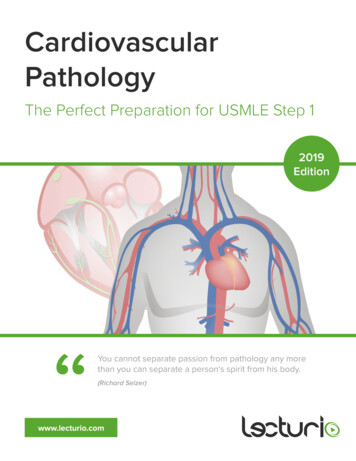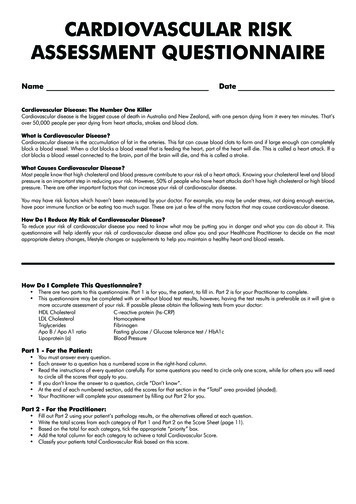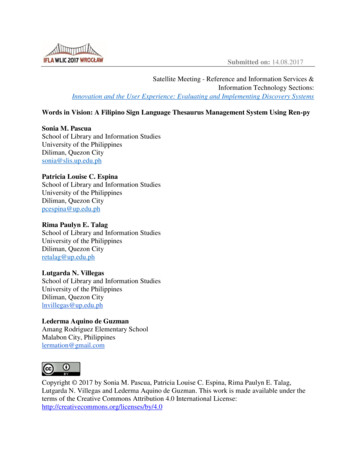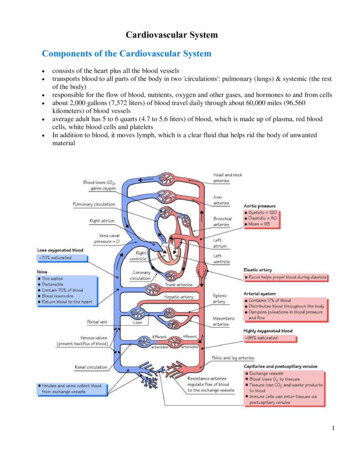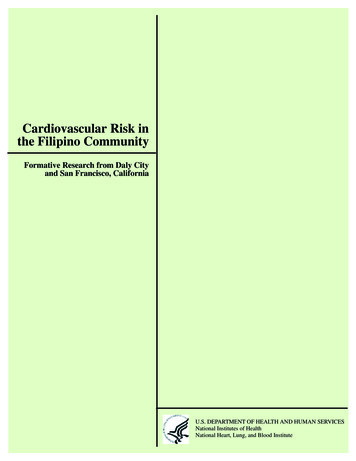
Transcription
Cardiovascular Risk inthe Filipino CommunityFormative Research from Daly Cityand San Francisco, CaliforniaU.S. DEPARTMENT OF HEALTH AND HUMAN SERVICESNational Institutes of HealthNational Heart, Lung, and Blood Institute
A collaborative report from the National Heart, Lung, and Blood Institute,the Asian & Pacific Islander American Health Forum,and West Bay Pilipino Multi-Services, Inc.
Table of ContentsAcknowledgements. iiiI.Forward .vII.Executive Summary .1III.Introduction.2IV.Methodology .2A. Community-Based Partner.2B. Data Collection .2C. Interviewer Training .3D. Translation of Research Instruments .3E. Data Feedback.3V.Demographics .4VI.Results.6A. What Does the Heart Symbolize? .6B. Concept of Health .6C. Pevention and Causes of Poor Health or Illness .6D. Major Health Concerns .6E. Filipino Lifestyle in the United States and in the Philippines .7i. Nutrition.7ii. Physical Activity.9iii. Stress .9iv. Tobacco.10v. Alcohol.11F. Personal Health .12i. Perceptions of Obesity .12ii. Factors Associated With Cardiovascular Disease.12iii. Perceptions of High Blood Pressure .13iv. Perceptions of High Blood Cholesterol .13v. Perceptions of Heart Disease .13vi. Alternative Health Care Services.14G. Engaging in Healthy Behaviors .14i. Confidence in Maintaining Heart Healthy Habits .14ii. Motivations and Barriers for Physical Activity .15H. Health Education and Promotion .15i. Health Information Sources .15ii. Engaging Community Residents in Heart Health.16iii. Problems Acquiring Medical Help or Services .17iv. Feedback on NHLBI Publications .17i
VII.Discussion .17A. Assets in the Community .17B. Awareness of Health Issues .17C. Factors That Increase Risk of Cardiovascular Disease.18D. Motivations and Barriers for Physical Activity .19E. Prevention and Intervention Strategies .19VIII.Limitations of the Study.21IX.Conclusion .22X.Appendices.23A. Appendix A: Training Materials.24i. Key Informant Interview Training Protocol .25ii. Key Informant Interview Training Handout .26iii. Indepth Interview Training Protocol.30iv. Indepth Interview Training Handout .31B. Appendix B: Interview Guides .37i. Focus Group Guide .38ii. Key Informant Interview Guide.45iii. Indepth Interview Guide .52C. Appendix C: Interview Guides (Tagalog).65i. Key Informant Interview Guide.66ii. Indepth Interview Guide .73ii
AcknowledgementsAdvisory CommitteeMagelende McBride, Ph.D., M.S.N., R.N.Community LiaisonCurtiss Takada Rooks, Ph.D.ConsultantAsian and Pacific Islander American Health Forum staffTracy L. Buenavista, B.A.Research AssistantRoselyn N. CalangianProject AssistantTessie GuillermoFormer Executive DirectorBetty Hong, M.P.H.Former Director, Community Health Development DivisionSusana M. Lowe, Ph.D.Project CoordinatorShobha Srinivasan, Ph.D.Research DirectorPrincipal InvestigatorJoon Ho YuTobacco and Cancer CoordinatorWest Bay Pilipino Multi-Services, Inc., staff and volunteersDaisy CruzInterviewerGrace CruzIntervieweriii
West Bay Pilipino Multi-Services, Inc., staff and volunteers (continued)Cheryl DeocampoInterviewerPia GalindoInterviewerEdwin D. JocsonExecutive DirectorEric M. LandasInterviewerDivine MarceloInterviewerSherille PedronInterviewerNational Heart, Lung, and Blood Institute, Office of Prevention, Education, and ControlstaffMatilde Alvarado, M.S.N., R.N.Coordinator, Minority Health Education and Outreach ActivitiesRobinson Fulwood, Ph.D., M.S.P.H.Senior Manager for Public Health Program DevelopmentEllen Sommer, M.B.A.Public Health AdvisorJuliana Tu, M.S., C.H.E.S.Community Health SpecialistWe would especially like to thank the members of the Filipino community in Daly City and SanFrancisco, California, who generously gave their time, effort, and invaluable insight for thisreport.iv
I. ForwardThe Healthy People 2010 report outlines the current status of the Nation’s health and theprojected health objectives to be reached by the end of the decade. The two main goals ofHealthy People 2010 are to increase the quality and years of healthy life and to end disparities inthe burden of disease. The NHLBI is committed to meeting the goals set forth in Healthy People2010, including ending the burden of disease for all racial and ethnic groups. The Institute hasdeveloped programs and initiatives to address high blood pressure, high blood cholesterol, earlywarning signs of heart attack, asthma, obesity, and sleep disorders.With this report on the Filipino community, we are gaining a greater understanding of the AAPIsubgroups that have been largely overlooked. In fact, Filipinos are rarely studied even thoughthey represent the third largest Asian subgroup in the United States, based on the 2000 Census.California has the largest number of Filipinos in the Nation and the largest population ofFilipinos outside of Manila. Cardiovascular disease and stroke cause more than half of Filipinodeaths.Heart disease is the leading cause of death for all Americans, including the Filipino population.We now have the opportunity to build partnerships within Filipino communities to focus localcommunity action on creating heart disease prevention activities. Through the development andimplementation of focused, culturally sensitive, and language-appropriate heart health strategies,we can help to prevent the development of heart disease risk factors in Filipino communities andhelp address the Healthy People 2010 goal of eliminating racial and ethnic disparities in heartdisease risk. Together, we can make a difference!Claude Lenfant, M.D.DirectorNational Heart, Lung, and Blood InstituteNational Institutes of Healthv
II. Executive SummaryAsian Americans and Pacific Islanders (AAPIs) are the fastest growing racial/ethnic group in theUnited States. They have varying socioeconomic characteristics, levels of acculturation,immigration history, and health profiles. The AAPI population is extremely diverse; itsmembers have ancestral ties to approximately 50 Asian and Pacific Islander nations. Heartdisease is the leading cause of death among these groups, but its impact on each group varies.For instance, high blood pressure is a major problem among Filipinos and control rates areparticularly poor.The National Heart, Lung, and Blood Institute (NHLBI) worked in partnership with the Asian &Pacific Islander American Health Forum (Health Forum) to conduct an assessment of thecardiovascular health status of AAPIs nationwide. The first AAPI populations studied were theFilipino communities in Daly City and San Francisco, California. These particular communitieswere chosen for their strong family and community support. Other populations to be studiedinclude Vietnamese, Cambodians, and Native Hawaiians.This report focuses on the Filipino population. Three formative research methods were used tostudy the Filipino communities: (1) focus groups with staff and volunteers from a localcommunity service agency, (2) key informant interviews with community leaders, and (3)indepth interviews with community residents conducted by trained bilingual (English andTagalog) facilitators. This report provides insights into the Filipino community, its perceptionsand knowledge of heart disease, and motivations to making lifestyle changes.Results from this study indicate that Filipinos in the United States are concerned about theiroverall health. There is highly consistent and convergent evidence that this population is at highrisk of developing cardiovascular disease. Filipinos, particularly new immigrants, aresusceptible to stress from work and family issues. Some of their coping strategies includeunhealthy eating and smoking. Outreach and education interventions for this population mustaddress dietary habits, blood pressure and blood cholesterol control, tobacco use, physicalactivity, stress, and socioeconomic concerns.1
III. IntroductionSince 1972, NHLBI has translated and disseminated information to the public to promote publichealth and prevent and control heart, lung, and blood diseases and sleep disorders. To date, theNHLBI has supported national cardiovascular initiatives for the African American, AmericanIndian/Alaskan Native, and Latino populations. This is its first national effort in support of aNational AAPI Cardiovascular Initiative. The NHLBI’s main objective is to collaborate withAAPI community-based organizers, key informants, and community members to conductcardiovascular health needs assessments in specific ethnic communities.In August 2000, NHLBI funded the Asian & Pacific Islander Health Forum (Health Forum) toconceptualize and implement a formative research project to gain a greater understanding of theattitudes toward and knowledge of health practices related to cardiovascular disease (CVD)among selected AAPI communities. This report highlights the main findings from the Filipinocommunity.The information collected under this project was approved as part of the Office of Managementand Budget (OMB) blanket clearance project. Blanket clearance number 0937 was approved andadministered by the National Institutes of Health (NIH) as a means to expedite the collection ofconsumer information to enhance program planning and development activities and to improvedelivery to and utilization of health information by NIH customers.IV. MethodologyA. Community-Based PartnerIn order to formulate culturally appropriate health messages and tools for specific populations,community-based organizations (CBOs) were chosen to conduct cardiovascular health needsassessments in AAPI communities. For the Filipino needs assessment study, the Health Forumpartnered with West Bay Pilipino Multi-Services, Inc. (West Bay), because of its reputation as anadvocate and a resource for the Filipino community. West Bay agreed to interview communitymembers and leaders in both Daly City and San Francisco. West Bay is a consolidation of sixestablished community service agencies (youth, employment, legal aid, etc.) that provideservices in a variety of languages and Filipino dialects.B. Data CollectionThe data were collected through three methods:1. Focus groupThe focus group participants consisted of nine staff members and volunteers from West Bay.The focus group was conducted in English; however, some participants chose to speak inTagalog. The focus group was tape recorded, transcribed, and translated.2
2. Key informant interviewsFour members of nonprofit organizations and the Catholic Church were invited to participatein individual interviews as leaders of their communities. Two of the interviews wereconducted in English and two were in Tagalog. Participants had to have held a formal orinformal position of leadership in the Filipino community to be a key informant.3. Community indepth interviewsTwenty-six community residents who use West Bay services were chosen to participate in anindepth interview about their susceptibility to CVD. Five interviews were conducted inTagalog and 21 were in English.C. Interviewer TrainingInterviewers were trained during one 4-hour session at West Bay. The training took placeimmediately following the focus group with the staff and the volunteers. This enabledinterviewers to become familiar with the scope of the project as well as some of the specificquestions they would be asking community members. See Appendix A for detailed trainingmaterials.D. Translation of Research InstrumentsStep 1: The research instruments were first developed in English.Step 2: Two bilingual and bicultural Filipinos, who were well versed in Tagalog and otherFilipino dialects, were asked to do two translations of the instruments.Step 3: The primary investigator, coordinator, and translators met to revise the instruments.Step 4: West Bay staff reviewed the instruments to ensure cultural and linguistic appropriateness.Step 5: Upon completion of the interviews, the interviewers made recommendations for futuredata collection.See Appendix B for the English instruments and Appendix C for the Tagalog instruments. E. Data FeedbackAfter preliminary results were identified, the coordinator and the bicultural/bilingual researchassistant met with the interviewers. The purpose was to check if the findings resonated withtheir experiences working with people in the community. The interviewers were also asked toelaborate on and clarify some of the data. The research instruments were developed explicitly for this assessment by the Health Forum, in conjunction withWest Bay and several members of the Filipino community in San Francisco. West Bay staff made changes to theTagalog translation just before and during the interviews with community residents. Before using the Tagaloginstruments, please review and revise them to meet your needs.3
V. DemographicsStudy participants varied greatly by age, gender, occupation, socioeconomic status, and healthcare coverage. The following tables and figures describe the community residents. Of allparticipants, 17 were males and 22 were females; the overall age range was 20 – 79 years (table1).Table 1—Number of participants by needs assessment methodology, sex, and ageGroupFocus groupCommunity leaders interviewCommunity residents interviewTotalMaleFemaleAge range42111752152223 – 45 years old37 – 55 years old20 – 79 years old20 – 79 years oldOf the 26 participants in the community resident interviews, about 58 percent were females; over65 percent were 45 years old or younger (table 2).Table 2—Number and percent of community resident participants by age and sexAge: Grouped by sample distribution20 – 29 years old30 – 45 years old46 – 60 years old61 years oldTotalMale531211 (42.3)Female453315 (57.7)Total (%)9 (34.6)8 (30.8)4 (15.4)5 (19.2)26 (100.0)Of the 26 community residents, 62 percent received 13 or more years of education, and 4 percentdid not receive an education (figure 1). Not shown in figure 1 is that no gender difference wasobserved in the level of education. Data on household income and size were also collected, alsonot shown in figure 1. The range of annual household income was between 20,001 and 40,000.The average household size was 4.2 people. Those with higher incomes had larger householdsizes, the presence of several adult workers, and people working more than one job.Figure 1—Percent of community resident participants by educational attainmentYears of education received01 through 1213 010203040506070Percent of community residents48090100
Of the 26 community residents interviewed, 91 percent were employed. Most of the residentswere employed; about 65 percent worked in administrative, service, and sales positions (figure2).Figure 2—Percent of community resident participants by occupational statusAdministrative support, service,industrial, or sales9%9%Professional/managerial ortechnical17%Homemaker65%Unemployedn 26Of the 26 community residents interviewed, 85 percent were born in the Philippines (figure 3).Not shown in this figure are the residents’ native language (85 percent say that a Filipino dialectis their native language), language preference, and length of stay in the United States (rangesfrom 2 – 32 years).Figure 3—Percent of community resident participants by place of birth15%Born in the PhilippinesBorn outside of thePhilippines85%n 265
VI. ResultsThe results of the cardiovascular health needs assessment revealed several findings about theFilipino culture, beliefs, and personal health behaviors. Community leaders described theircommunities as middle-class families with people of all ages. The two major languages used incommunication are English and Tagalog. Various Filipino dialects are also used, includingBicolano, Bisaya, Pampango, and Ilocano. A community leader stated that Filipino residents areactively involved in community activities, especially in the church because religion givesmeaning to their lives. The church is also a place where people meet others who share the samecultural backgrounds and find happiness. One leader described Filipinos as “hospitable to thosewho involve themselves [in the community], committed, generous, and have lots of gifts andtalents to share.”A. What Does the Heart Symbolize?When the community residents were asked about the heart and what it symbolizes for them,among the things they stated were love, life, strength, commitment, and perseverance.B. Concept of HealthWhen asked about the concept of health, focus group participants said that being healthy is veryimportant and that they know how to maintain good health. They stated that one way of stayinghealthy was to exercise. Community leaders agreed that good health is very important. Theyadded that good health is achieved when there is a balance between the mental, emotional, andphysical states of mind.C. Prevention and Causes of Poor Health or IllnessCommunity residents were asked to discuss prevention and illness separately, but they did notsee these as discrete concepts. They listed fatigue, stress, unhealthy eating, smoking, drug abuse,lack of concern for one’s health, and lack of exercise as factors related to poor health.Community residents understood the importance of prevention and the different preventivemeasures they can take to ensure a healthy heart. Being open minded, listening to their body,and getting health advice from trusted family members, friends, physicians, and ministers helpthem to stay healthy. Key community leaders said that illness in the Filipino culture is a sign ofa weak body, low resistance, and imbalance.D. Major Health ConcernsCommunity leaders named heart disease, high blood pressure, and diabetes as three of the topfive major health concerns in the Filipino community. The community leaders cited heredity of6
heart disease and a high fat, high cholesterol, and high sodium Filipino diet as reasonscardiovascular health-related diseases are big concerns. Other health concerns includedemphysema and breast cancer.E. Filipino Lifestyle in the United States and in the Philippinesi. NutritionThere are quite a few differences between the Filipino and American diets. First, theFilipino diet contains a lot of salt. Patis (fish sauce) is one of the most commoningredients in the Filipino diet. Bagoong (shrimp paste), anchovies and anchovy paste,and soy sauce are also popular ingredients. Despite the fact that community residentsbelieve that eating less salt is better for their blood pressure and health in general, theyare not likely to reduce their salt intake.Second, traditional Filipino foods include ingredients from a variety of cultures.Common Chinese ingredients such as oyster sauce are regularly used. Vinegar, coconutmilk, lime, tamarind, garlic, ginger, onion, and pepper are also key ingredients. Theavailability of ethnic Filipino ingredients is great. In fact, there is a greater affordabilityand variety in the local United States markets compared with those in the Philippines.This allows more frequent use of these ingredients and in greater quantities.Third, traditional Filipino dishes such as fried fish, roasted pork, pancit, lumpia, adobo,and desserts rich in sugar and starch are eaten frequently. Table 3 lists traditionalFilipino foods. These native dishes are more often prepared and served at gatherings,which occur frequently. One woman expressed the popularity of fried, fatty foods bydeclaring, “I like that crispy, crispy, crispy.”Table 3—Traditional Filipino foodsTraditional dishDescriptionPancitSautéed vegetables, shredded chicken, shrimp, and rice noodlesLumpia (fried egg rolls)Ground beef or pork with mixed vegetablesAdoboOnions, garlic, pork or chicken, soy sauce, and vinegarDinuguan (chocolate meat) Pork blood, pork, tripe, onions, garlic, and peppersKare-kareOx tail, peanut butter, bok choy, long green beans, salt, pepper,and shrimp pasteSinigangBeef, salmon, milk fish, or pork ribs with fresh tamarind ortamarind mix, tomatoes, long green beans, onions, taro root, andfish sauceLechonRoasted pigCrispy pataDeep fried pork legChicharonPork rinds served with vinegar and chiliFried chickenChicken deep fried in oil.Fried fishFish deep fried in oil.7
Fourth, focus group members discussed the traditional practice of “gift giving”(pasalubung) as a barrier to eating healthy. Pasalubung is customary when one personvisits another, such as dinner gatherings or after returning from a trip. Communityresidents described the gifts as unhealthy for the body. Alcohol, roast pork, adobo, andchicharon are common gifts. It is considered rude and disrespectful if the gifts are notwell received, particularly if an older person offers them.Fifth, residents also believe that immigrants seeking comfort food can also lead to poorhealth. Comfort food provides a sense of home and security and helps to alleviate thestressors of adapting to life in a new country.Lastly, residents talked about the affordability of American foods, which are moreexpensive overseas. Many Filipinos who immigrate to America are poor. Foods thatthey are not able to afford in the Philippines can be bought in the United States at areasonable price. In the United States, Filipinos frequent fast-food chains and take-outrestaurants that serve high-fat, high-sodium, and high-cholesterol foods, usually reservedfor wealthy people in the Philippines. Because of this practice, Filipinos in the UnitedStates consume more unhealthy foods.The community residents described home-cooked meals as less salty, less oily, and lessfatty than restaurant food. Residents tend to use a fresher and larger variety of fruits andvegetables and less meat, which gives them the option to choose healthier foodalternatives.Figure 4 shows the kinds of food community residents consumed 2 days prior to thestudy. Generally, the community residents eat a healthy diet with lots of fruits andvegetables. However, there were just as many residents who consume foods high in fatand cholesterol, such as red meat and snacks (figure 4).Figure 4—Percent of community resident participants by type of food reported andnumber of servingsSnacksVegetable proteinFishFood typeChicken3 servings1 servingRed meatDairyFruitsVegetablesHomecooked mealsEthnic dishes010203040506070Percent of community residents88090100
ii. Physical ActivityOverall, community residents believe that physical activity is important (figure 5).However, they preferred walking rather than vigorous exercise. Community leadersadded that Filipinos often do physical labor at work and are also active at home. Doinglaundry, cleaning the house, and gardening are some of the chores that allow Filipinos tostay active in their daily life. These activities should be recognized as heart healthypractices. It can be misleading to look at physical activities in the Filipino community asthose typically recognized in Western culture, such as aerobics, use of exercise machinesin gyms, etc. Furthermore, it is important to pay attention to the kinds of communityactivities that Filipinos engage in that provide aerobic activity, such as dancing.As with dietary regulations, adherence to exercise was considered “a matter of priorities,”as one man in the focus group explained. Working for wages to support the family anddoing daily chores around the house are given greater priority over physical activity.However, as figure 5 shows, all forms of physical activity are important to the Filipinolifestyle. Eighty-one percent of the community residents exercised at least once in thelast month, while only 38 percent regularly participate in organized community activities(figure 5).Figure 5—Percent of community resident participants engaging in physical activity byattitudes and behaviorAttitudes and behaviorExercised once last monthParticipate in organized activitiesSomewhat importantVery important0102030405060708090Percent of community residentsiii. StressFifty-four percent of the community residents said that they lead somewhat to verystressful lives. Common stressors include: WorkSchoolCaring for the family and childrenMoney9100
Filipinos relieve stress by talking with friends and family, exercising, praying, listeningto music, shopping, watching television, and smoking.iv. TobaccoCommunity residents identified various effects of smoking, which included damage tothe liver and lungs, cancer, and high blood pressure. “Looking cool and sophisticated”are some of the motivating factors that drive Filipinos to smoke. Smoking was alsomentioned as part of the natural process of growing up, which may explain why residentsare concerned about the number of children who smoke.A majority of the community residents (n 21) have been exposed to smoke from family,friends, coworkers, clients, and strangers. Figure 6 shows the percent of communityresident participants exposed to tobacco smoke.Figure 6—Percent of community resident participants exposed to environmental tobaccosmoke by source of exposurePercent of community ntsStrangersSources of exposureOf the 26 community residents, only 9 reported that they used tobacco products. Withinthis group of 9: The average number of years smoked was 13 years (SD 7.2 years).Five smoked l
Cardiovascular disease and stroke cause more than half of Filipino deaths. Heart disease is the leading cause of death for all Americans, including the Filipino population. We now have the opportunity to build partnerships within Filipino communities to focus local community action on creating heart disease prevention activities.
